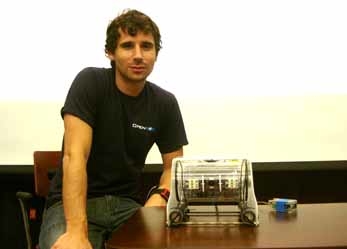The Number One Robotic Loving Fan Eric Stackpole
Fancy of peeking on what lies undersea, yet water bothers you much? You need Eric Stackpole’ ROV robot. This American guy deserves a medal by making us easier to explore underwater area in many countries with his robot design. Superkids Indonesia had a chance to interview the man at Consulate General odf USA Office in Surabaya, after last Wednesday, August 13th 2014 workshop
Hi, Eric. What brings you to Indonesia?
The US State Department was very kind to invite me on a speaker series across Indonesia. So far, I’ve been in Surabaya and Malang, and i will soon visit Jakarta and Bandung. This is my first time here!
When did you first time become interested at robotic? Do you have a family doing robotic too?
I’ve always been interested in technology that allows people to do things they wouldn’t normally be able to do. But i became particularly interested in underwater robotics around the end of high school (around 2002-2003) after competing in a MATE ROV competition. To my knowledge, i’m the only one in my family who works with robots.
What drew you into robotic?
I like the idea of being able to see or do things in a place i can’t physically go myself. Specifically, this field is called ‘telerobotics’. I believe telerobtics holds huge potential as a tool for exploration. And it’s my goal to help the world appreciate that potential.
What is your first robotic work?
When i was very young, i played with legos and built things from parts i found lying around. When i was a little older, my parents bought me a toy robotic arm that really liked. Around high school, i got into remote control airplanes and cars. And by the beginning of college, i built my own robot which i called ESTR (which stands for Eric Stackpole Telepresence Rover). ESTR was a telerobot i could control from my dorm room which sent live video to me. So i could go to classes without having to show up in person.
Wow, cool! So, where did you get the idea of constructing under water robot?
During graduate school, i was spending a lot of time working on satellites for NASA. It was frustrating to me that it requires a huge amount of money to put something into orbit on a rocket, and i started thinking of what other places could be explored with telerobotics that were easier to get to. Some people in my lab were working on ROVs, and i realized that that was something i wanted to get into.
How long did it take on experimenting and assembling to get your ROV as the world knows today?
The ROV we have today still isn’t perfect, but it’s taken us about three years to get here. Only in the last year or so have we even gotten to the point where the ROV works.
What is the advantage of ROV? What can it do down there?
The ROV’s main job is to send live HD video up to the surface so the person controlling it can see what it looks like down there. The ROV is also capable of carrying additional sensors that measure things like temperature, salinity, and pressure. We hope that one day, someone may even develop a robot arm so that the ROV can pick things up!
Are there many people you know using ROV?
OpenROV has a community of nearly 4000 people across 50 countries. I’m always excited to get photos and video from around the world of OpenROVs being used to explore unknown places, or give a new perspective to places that may already be familiar. I hope that some of the greatest discoveries that have yet to be made about underwater places will happen with OpenROVs.
What is the objective of OpenROV?
The objective of OpenROV is to make exploration of the unknown accessible to anyone. We hope to democratize exploration.
Is it true that you spent some time working with NASA?
I worked at NASA Ames Research Center for about three years between 2008 and 2011, during college as an intern and contractor. The main project i worked on while there was to design a ‘deorbiting mechanism’ to be used on the O/OREOS spacecraft which would cause the spacecraft to re-enter the Earth’s atmosphere more quickly than it otherwise would so that it would not be a hazard to future spacecraft. That design is currently in orbit. You can find more about it in a talk I gave here.
So, what is your next goal? What else are you planning on constructing?
The next step for OpenROV that I’m most excited about is connecting ROVs to the internet. I hope that soon, people around the world will be able to fly ROVs in far-away places just like logging into a computer game. We’ve also just launched a website called openexplorer.com where people can post stories about the adventures they’re going on. There is a lot going on right now at OpenROV!
BioFact
Name: Eric Stackpole
Born : 1984
Education: BS in Mechanical Engineering from San Jose State University
Address: 2222 3rd St, Berkeley, CA 94710
HAFIDA INDRAWATI
PHOTOS: HAFIDA INDRAWATI


 Indonesia
Indonesia















